When I saw the first signs of tent caterpillars outside our flat, I kept the sighting to myself.
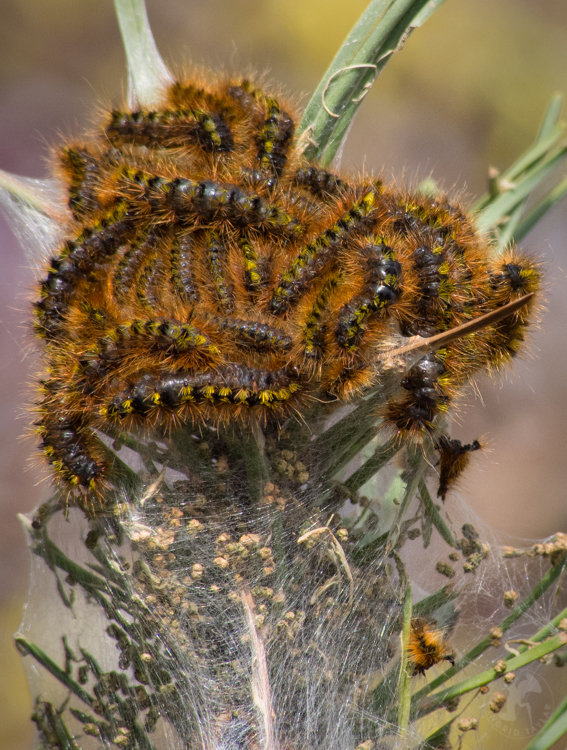
We have a neighbor, a home owner just up the hill who screams at crows — and who dead-heads her plants to the point of denuding them. I knew if she saw this tiny tent on the fir tree, she’d make short work of the squirmers inside.
This spring we had what’s called an “outbreak” of tent caterpillars in Seattle — Malacosoma californicum — a cyclical occurrence of every six to ten years where these white, diaphanous tents drape across branches of alder, apple, ash, birch, cherry, cottonwood, willow, fruit trees, and roses. The tents are shelter, shade, and molting sites for the vivid larvae inside. The caterpillars venture out in the day to feed on foliage, then return each night to hunker down in their fortress. The black speckles are frass, or caterpillar waste which accumulates in their temporary home.
As they feed, they turn leaves into lattice, finishing each cluster of green before moving up the branches to the next.
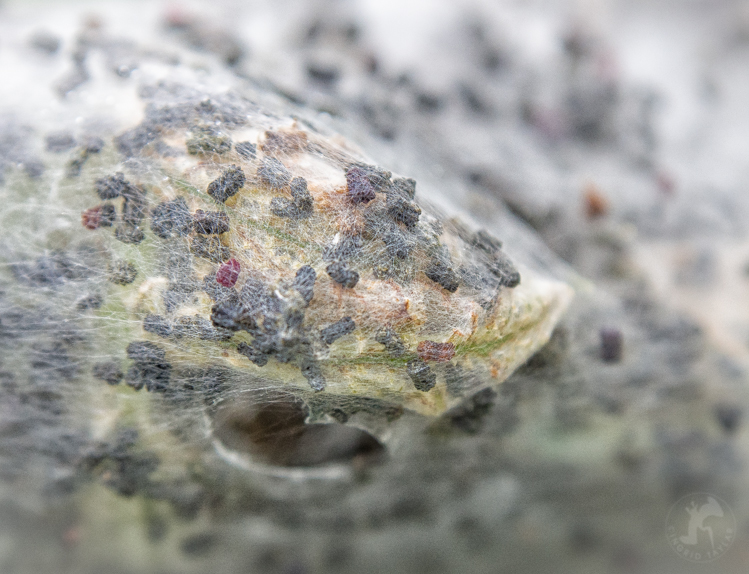
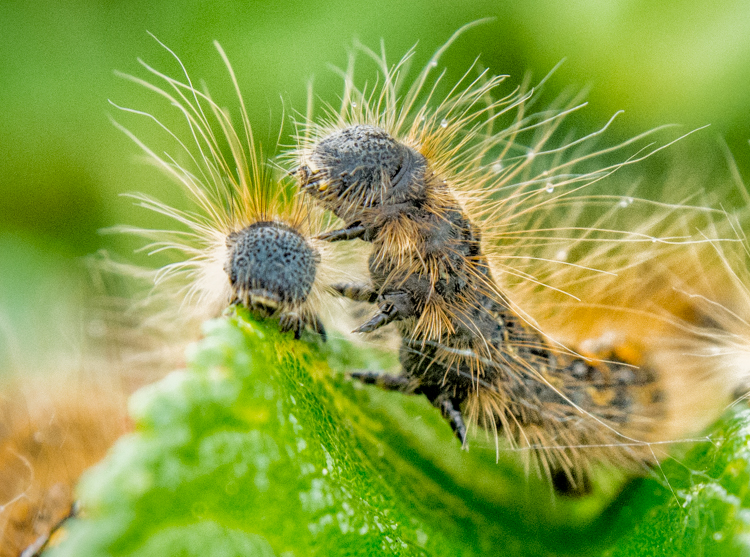
As damaging as this looks, the consensus of information is that trees in good health will survive these short spurts of caterpillar activity. Tent caterpillars may eat up to 20 percent or so of leaves during their four to six weeks of activity, but trees are adapted to rejuvenation.
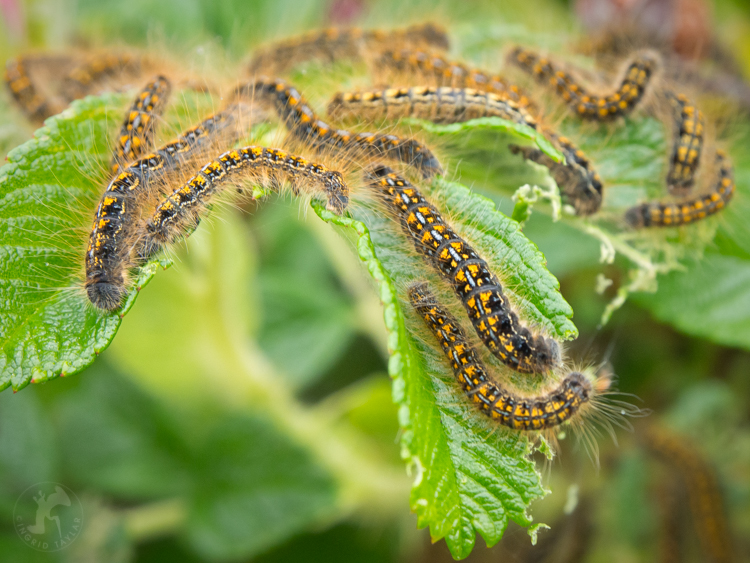
Department of Natural Resources manager Karen Ripley, quoted in Small Forest Landowner News, explained that “the trees are not being devastated. Healthy trees are unlikely to be damaged, even if all their leaves are consumed. Deciduous trees are ‘used to’ replacing their foliage each year and will even produce a second crop of foliage in the next few weeks. The plants growing beneath the caterpillar laden trees are getting extra exposure to sunlight and a shower of nutrients in the feces and leaf fragments that drop from above.”
That’s why I was particularly annoyed when I came upon this note in a local arts publication:
“Every six to ten years — including now — populations of these voracious defoliators explode. The fuzzy, inch-long orangey bugs get their name from the nests they spin, where they amass in the hundreds. Word from Fish & Wildlife Dept: Kill on sight.”
I wasn’t able to find the “kill on sight” information at the Washington Department of Fish and Wildlife website, and have to assume it came from a referenced source. The USDA, when discussing forest damage by tent caterpillars says, “because western tent caterpillar is more of a nuisance than a damaging pest, infestations normally are allowed to run their course without intervention.”
Their documentation goes on to say:
A large complex of natural enemy species feeds upon western tent caterpillar and, together with unfavorable weather and foliage depletion, regulates population size. High populations usually collapse within a year or two due to natural controls, although outbreaks in the Southwest have lasted longer and caused significant aspen mortality.”
The Washington Department of Natural Resources adds that “even the trees reduce the digestibility and nutrient content of their leaves in response to caterpillar activity.”
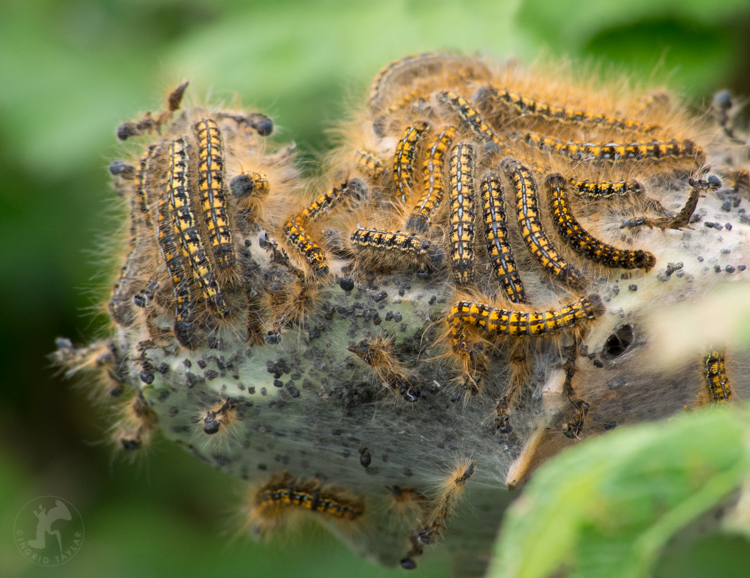
I saw Facebook posts with tent caterpillar photos captioned with “ewwwww” and “creepy.” I also saw loads of misinformation suggesting that these caterpillars cause total deforestation and plague — with people clipping, burning, and poisoning the tents and larvae. This reduces a potential food source for birds that feed on caterpillars and also puts those species at risk where poisons are used.
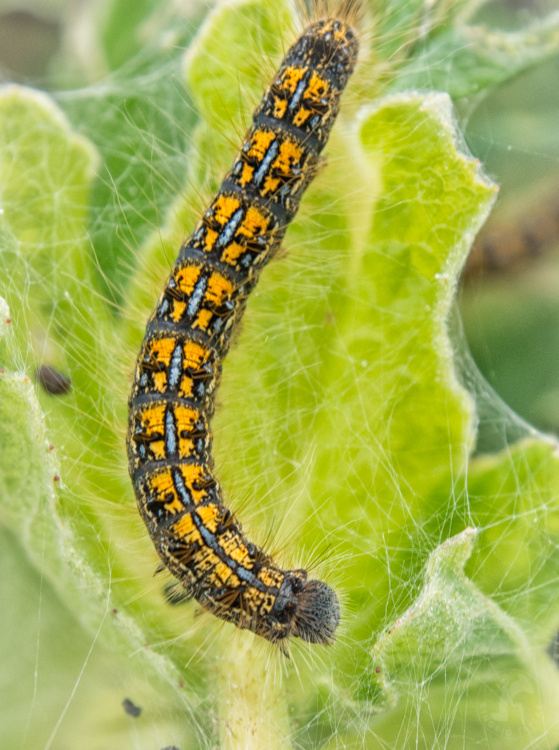
That was earlier this spring and what people didn’t seem to realize was that in a matter of weeks, these hungry caterpillars would stop eating and seek individual cocooning sites, sequestering themselves for mothdom. Then, they’d emerge as brown tent caterpillar moths and lay eggs which would overwinter until next spring to repeat the cycle.
After that, they will be gone, reappearing again after many years for their magical mystery tour. I might be the only one in my neighborhood remotely interested in observing and photographing these once-a-decade visitors. I look forward to their return. And when those silky masses burst out of the branches of my local trees, no one else will know — if I can help it.
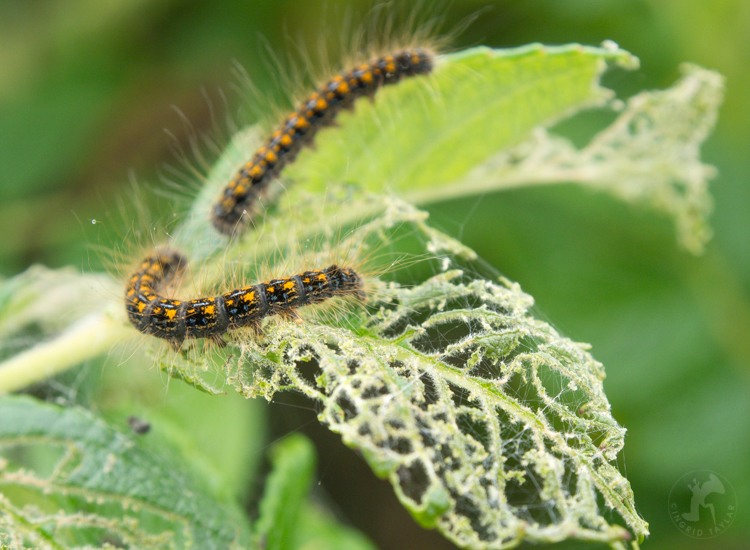


Gosh, misinformation trotted out by respected, reputable experts — yes, that’s probably a three-dundancy! — is so deadly.
Much more deadly than the cute tent caterpillars and their lovely lacy shawls EVER will be.
Indeed, I think such unwarranted fear, cast like a bottom-fishing trawling net by the trolling-for-dirt media and the ignorant masses, hauls in a load of, well, garbage.
Would that we could all be taught from our youth that nature performs tasks that help rather than hinder our good earth and its good “lings.”
Thank you for doing your part in halting this infestation of false facts and fears — the real foe — in its tracks, Ingrid.
Oh, I forgot to say: Love the pix! Especially the one of the frosted-looking leaves turned into “lattice.” If the veggie of choice for these cool cats were iceberg or romaine or Boston, we could call it “lattice lettuce.”
Ingrid, I love the close-up macro shots, and didn’t know anything about the emergence of these cyclical caterpillars. I also like the conglomeration shown in the first frame. What marvel! What colours and patterns you have shown! It is a myth that caterpillars destroy trees and plants. They defoliate, but that doesn’t mean they kill the plants or trees. What a misconception about these insects! Most people love to see butterflies flying all over, but the intricacies of such origins are often overlooked. Moths and bats are most important nocturnal pollinators in the wild. After butterflies and bees are done for the day, it’s time for the moths to come out at night and fulfill their duty. This is how perfect Nature is.
Perfect, indeed. And unduplicatable by mere mortals. If we would but take the time to stop, look, and listen, we would learn the truth, wouldn’t we, Maria?
Was it you who wrote in a private email to me that you love the quote accompanying the photos of a butterfly and a caterpillar in Chapter 27 of http://www.CreatureQuotes.com? Rather than recite it here, I’ll let Wild Beat readers scroll through the pages of that short chapter themselves — and be pleasantly surprised.
Speaking of the first frame, those closely intertwined, fuzzy insects make me think of a fur hat worn by a royal guardsman.
CQ:
It’s in this section:
https://www.creaturequotes.com/PDFs/CHAPTER%2027%20GALAH.pdf
“To be able to love a butterfly, we must care for the caterpillars too”-unknown author
I didn’t realize that each chapter had it’s own link — duh! Nor did I realize how long the chapter names in those links are!!!! I do know what Galah stands for, though. Thanks for sharing the beautiful quote, Maria. You and Ingrid follow its directions to the letter — and the lens!
Thanks for sharing the beautiful quote, Maria. You and Ingrid follow its directions to the letter — and the lens!
A superb post in so many ways – valuable information, wonderful photos to illustrate your text and as always, top-notch writing.
We also get sporadic outbreaks of tent caterpillars and I’ve seen folks react to them in just the way you describe. Thanks for helping to clear up some of the rampant misinformation about them. Great topic!
Viewing these caterpillars as a pest problem is the kind of reductionist thinking that human beings excel at and that causes us so many problems (and also causes us to cause so many problems!). “When we try to pick out anything by itself we find it hitched to everything else in the Universe.”
Great information and images Ingrid!
Wonderful post to celebrate the beauty and complexity of nature! A fresh look at a marvelous creature that most people just “hate” without even thinking about it. Thank you!
Great information! I always thought they harmed the tree.